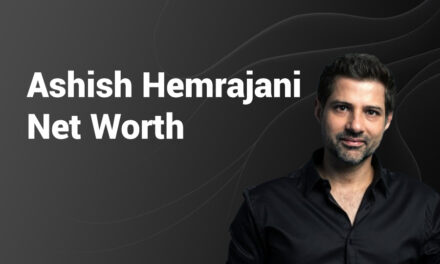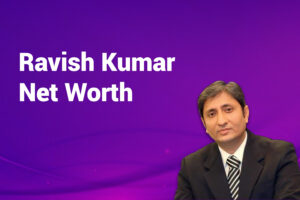Subhash Chandra is one of India’s most influential entrepreneurs. His journey from a small-town trader to the founder of Zee Entertainment and Essel Group highlights his remarkable resilience and vision.
Over the decades, he built an empire spanning television broadcasting, direct-to-home services, amusement parks, packaging, infrastructure, and education.
This article takes an in-depth look at Subhash Chandra’s net worth, business ventures, early struggles, and achievements.
Early Life and Humble Beginnings
Subhash Chandra was born on November 30, 1950, in Adampur, Haryana. He grew up in a family involved in agriculture and trading. Unlike many successful business leaders, Chandra did not have the privilege of completing higher education. He dropped out of school at 17 to support his family’s rice trading business. This decision marked the beginning of his practical learning in commerce and entrepreneurship.
Despite financial limitations, Chandra showed remarkable foresight. He soon moved beyond the family’s modest business and explored new opportunities that aligned with India’s evolving economic landscape in the late 20th century.
Founding Essel Group
In 1976, Subhash Chandra renamed the family company Essel Group. He began diversifying into packaging with Essel Packaging, which supplied laminated tubes to major FMCG brands. This bold move positioned him as a trusted partner for consumer goods giants.
Essel Group then expanded into various industries, including infrastructure and amusement parks. The launch of EsselWorld, one of India’s largest amusement parks, showcased his willingness to experiment with consumer-oriented businesses.
Entry into Media: Birth of Zee TV
The most significant turning point came in 1992 when Chandra launched Zee TV, India’s first private satellite television channel. At the time, the Indian television market was dominated by the state broadcaster, Doordarshan. Zee TV broke the monopoly and gave Indian audiences access to diverse entertainment.
Zee’s success redefined Indian media. The channel’s innovative programming attracted millions of viewers, establishing Zee as a household name. Today, Zee Entertainment Enterprises runs over 50 channels in 11 languages, with a weekly reach of more than 572 million viewers across 120 countries.
Building a Media Empire
Following Zee’s success, Subhash Chandra expanded further:
- Dish TV (2003): India’s first direct-to-home service.
- DNA (2005): An English-language daily newspaper.
- Zee Learn: Focused on educational institutions and e-learning.
- Zee Studios: A film production company that entered mainstream Bollywood.
This diversification helped Zee Entertainment become one of India’s largest media conglomerates.
Challenges and Setbacks
Like most business leaders, Chandra faced setbacks. In 2019, amid Essel Group’s debt crisis, he resigned as chairman of Zee Entertainment, later becoming chairman emeritus. The group defaulted on ₹616 crore NCD bonds in 2020, creating pressure on his reputation and finances.
Despite these challenges, Subhash Chandra managed to safeguard Zee’s legacy. His contributions to the Indian media sector remain unmatched, even as his business empire evolved.
Political Career
In 2016, Chandra entered politics as a Rajya Sabha Member of Parliament from Haryana. His political role further established him as an influential voice in India’s policymaking circles. Though he later shifted focus back to business and media, his stint in politics underlined his wide-ranging influence.
Investments and Net Worth
As of 2025, Subhash Chandra’s net worth stands at approximately $2.50 billion, placing him at #916 among the world’s richest individuals. His wealth stems from a combination of:
- Equity Holdings: Major investments in Zee Entertainment and Essel Group ventures.
- Private Investments: Holdings in companies such as Vedant Fashions (₹380 crore) and Stylenook (₹4.8 crore).
- Media and Broadcasting Assets: Global expansion of Zee channels across 120 countries.
- Packaging Business: Essel Packaging continues to be a major supplier to global FMCG companies.
Recognition and Awards
Subhash Chandra has received numerous awards for his entrepreneurial achievements:
- International Emmy Directorate Award (2011).
- Canada India Foundation Global Indian Award.
- Named as “Asia’s Murdoch” for revolutionizing India’s private television landscape.
- Published autobiography “The Z Factor,” which highlights his journey.
Business Philosophy
Chandra’s philosophy revolves around risk-taking and long-term vision. He has often emphasized that calculated risks are essential for growth. His focus on innovation, content creation, and audience engagement made Zee a pioneer in Indian broadcasting.
Legacy and Impact
Subhash Chandra’s legacy is tied to the democratization of television in India. He transformed the way Indians consumed media and entertainment. Beyond wealth, his contribution is measured by Zee’s ability to connect millions of households and shape India’s cultural fabric.
Family and Personal Life
Chandra is married to Sushila Devi. His children include Punit Goenka, Amit Goenka, and Amogha Harsha, who are also involved in business leadership roles. Punit Goenka, in particular, has been instrumental in leading Zee Entertainment’s global growth.
Future Outlook
Although Chandra stepped back from some leadership roles, Essel Group continues to diversify and stabilize its businesses. Zee’s influence in global entertainment remains strong, and new partnerships may further boost revenues. His investments in fashion and tech also signal continued interest in emerging industries.
Deeper Look into Subhash Chandra’s Business Strategies
Subhash Chandra’s rise to billionaire status was not built on a single stroke of luck but on consistent strategic thinking. His entry into media was a calculated risk when satellite television was nearly non-existent in India. At that time, very few entrepreneurs believed that private broadcasting could compete with state-run Doordarshan. Chandra not only believed in it but also anticipated the explosion of demand for diversified entertainment in the 1990s.
What separated him from others was his ability to move fast. While many were skeptical about regulatory hurdles, he collaborated with Hong Kong–based Star TV for satellite infrastructure, ensuring Zee TV had the technological backing to reach millions of Indian homes. This approach of building alliances and leveraging international expertise helped Zee establish dominance early on.
Diversification Across Consumer Segments
Chandra’s investments were spread across industries that touched everyday consumers. His foray into packaging positioned him at the backbone of FMCG supply chains. Essel Packaging became a reliable supplier for toothpaste, creams, and cosmetics manufacturers globally. This ensured Essel Group had a steady cash flow from an industry less prone to economic cycles.
Later, with Dish TV, he tapped into India’s growing middle-class households. Offering direct-to-home broadcasting gave viewers hundreds of channels at a time when cable television was limited in choice. Dish TV quickly expanded to millions of subscribers, generating large revenues for the group. By balancing B2B (packaging) and B2C (media, broadcasting, amusement) businesses, Chandra minimized risk while maximizing growth.
Net Worth Growth Over the Years
Chandra’s net worth crossed the $1 billion mark in the mid-2000s, when Zee Entertainment and Dish TV saw explosive growth. By 2010, Zee had established itself as one of Asia’s largest media companies, pushing his personal wealth higher. His investments in real estate and infrastructure further strengthened his financial standing.
Although debt issues reduced the group’s overall stability in the late 2010s, Chandra retained significant wealth through equity stakes and private holdings. As of 2025, his $2.50 billion net worth reflects both recovery and diversification, particularly through holdings like Vedant Fashions.
International Expansion
Zee Entertainment’s global growth is one of the strongest contributors to Chandra’s fortune. Starting with South Asian diaspora audiences in the UK, USA, and Middle East, Zee gradually entered markets in Africa and Southeast Asia. Zee TV, Zee Cinema, and Zee News became platforms not just for entertainment but also for cultural influence.
International licensing, subscription revenues, and partnerships with local broadcasters provided steady foreign income. These global operations insulated Zee from fluctuations in the Indian market. Chandra’s vision of making Zee a household name worldwide pushed its valuation and, in turn, his own net worth.
Key Financial Assets and Shareholdings
Breaking down his net worth reveals several strong components:
- Zee Entertainment Enterprises: Despite reducing his controlling stake, Chandra still holds valuable equity.
- Essel Packaging (now part of EPL Limited): Remains a consistent performer in the global packaging market.
- Dish TV India: One of the pioneers in India’s DTH sector.
- Private Investments: Notably, Vedant Fashions, where his stake is worth hundreds of crores.
- Real Estate Holdings: Properties in India and abroad, which appreciate steadily.
These diversified holdings ensure his personal fortune is spread across multiple industries.
Economic Influence and Industry Impact
Chandra’s business empire generated thousands of jobs. Zee Entertainment alone employs thousands across broadcasting, production, and digital platforms. Essel Packaging, with its manufacturing footprint, employs a global workforce. His ventures in amusement parks and infrastructure also contributed to urban development in India.
His influence is not limited to wealth creation. By introducing private broadcasting, he broke state monopoly, paved the way for competition, and fueled India’s media revolution. Rivals like Star Plus, Sony, and Colors entered later, but Chandra’s Zee remains the pioneer that set the stage.
Debt Crisis and Wealth Preservation
The Essel Group debt crisis of 2019–2020 forced Chandra to rethink his strategies. The group had borrowed heavily for infrastructure projects that did not yield expected returns. Defaults on bonds hurt the group’s credibility. For Chandra, this meant selling stakes and restructuring holdings.
Despite the setbacks, he preserved his billionaire status. His timely decision to step aside from active leadership allowed professionals to stabilize Zee while he focused on restructuring Essel Group. This resilience is why his net worth today remains at a global billionaire scale.
Philanthropy and Social Contributions
While most discussions center on his wealth, Chandra’s philanthropic efforts are equally noteworthy. He has supported initiatives in education through Zee Learn, which runs schools and preschools across India. Additionally, he has contributed to cultural preservation, rural development, and media literacy programs.
Through the Essel Foundation, he has funded projects that aim at skill development, women empowerment, and healthcare access. His approach combines business-driven social initiatives with targeted philanthropy, creating measurable impact.
Public Perception and Legacy in Business Literature
Chandra’s story is frequently cited in business schools and entrepreneurial case studies. His autobiography The Z Factor is widely read among management students for its candid portrayal of successes and failures. His journey from a small-town background to “Asia’s Murdoch” offers valuable lessons about vision, risk-taking, and adaptability.
Although his legacy faced criticism during debt troubles, his pioneering role in Indian television overshadows the setbacks. In many ways, his resilience during crises has reinforced his reputation as a long-term player in Indian business.
Current Influence in 2025
Even after stepping back from operational roles, Chandra continues to hold influence as an industry elder. His children, especially Punit Goenka, lead Zee’s day-to-day operations. Chandra’s advisory role, coupled with his continued investments, ensures he remains relevant in shaping media strategies.
With Zee expanding into digital platforms and OTT services, his legacy now connects to India’s streaming future. This expansion may further solidify the financial standing of the group and sustain his personal wealth.
Conclusion on Net Worth Stability
Subhash Chandra’s net worth of $2.50 billion in 2025 reflects decades of innovation, resilience, and adaptation. Despite debt crises, leadership changes, and evolving competition, he has remained within the global billionaire circle. His diversified investments across media, packaging, real estate, and fashion ensure long-term wealth preservation.
From a rice trader’s son in Haryana to one of the world’s most influential media moguls, his story demonstrates how vision and risk-taking can transform fortunes. While future valuations may fluctuate, Chandra’s impact on India’s business and media landscape ensures his name will remain significant for decades.










